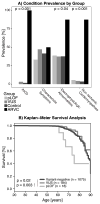Electronic health record phenotype in subjects with genetic variants associated with arrhythmogenic right ventricular cardiomyopathy: a study of 30,716 subjects with exome sequencing
- PMID: 28471438
- PMCID: PMC5671380
- DOI: 10.1038/gim.2017.40
Electronic health record phenotype in subjects with genetic variants associated with arrhythmogenic right ventricular cardiomyopathy: a study of 30,716 subjects with exome sequencing
Abstract
PurposeArrhythmogenic right ventricular cardiomyopathy (ARVC) is an inherited heart disease. Clinical follow-up of incidental findings in ARVC-associated genes is recommended. We aimed to determine the prevalence of disease thus ascertained.MethodsIndividuals (n = 30,716) underwent exome sequencing. Variants in PKP2, DSG2, DSC2, DSP, JUP, TMEM43, or TGFβ3 that were database-listed as pathogenic or likely pathogenic were identified and evidence-reviewed. For subjects with putative loss-of-function (pLOF) variants or variants of uncertain significance (VUS), electronic health records (EHR) were reviewed for ARVC diagnosis, diagnostic criteria, and International Classification of Diseases (ICD-9) codes.ResultsEighteen subjects had pLOF variants; none of these had an EHR diagnosis of ARVC. Of 14 patients with an electrocardiogram, one had a minor diagnostic criterion; the rest were normal. A total of 184 subjects had VUS, none of whom had an ARVC diagnosis. The proportion of subjects with VUS with major (4%) or minor (13%) electrocardiogram diagnostic criteria did not differ from that of variant-negative controls. ICD-9 codes showed no difference in defibrillator use, electrophysiologic abnormalities or nonischemic cardiomyopathies in patients with pLOF or VUSs compared with controls.ConclusionpLOF variants in an unselected cohort were not associated with ARVC phenotypes based on EHR review. The negative predictive value of EHR review remains uncertain.
Figures


References
MeSH terms
Grants and funding
LinkOut - more resources
Full Text Sources
Other Literature Sources
Miscellaneous

